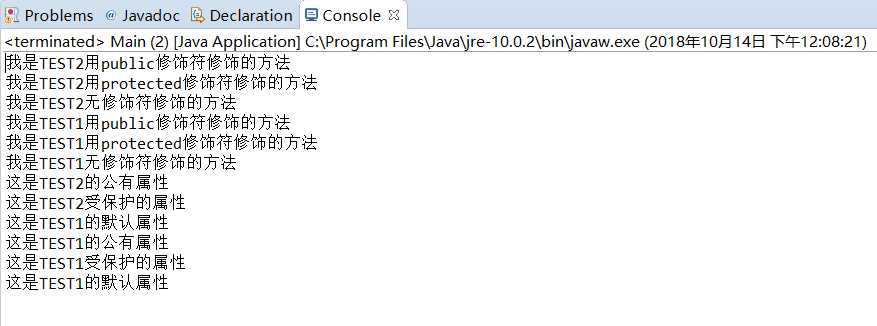焦旭超201771010109《面向對象程序設計(java)》第七周學習總結
實驗目的
(1)進一步理解4個成員訪問權限修飾符的用途;
(2)掌握Object類的常用API用法;
(3)掌握ArrayList類用法與常用API;
(4)掌握枚舉類使用方法;
(5)結合本章知識,理解繼承與多態性兩個面向對象程序設計特征,並體會其優點;
(6)熟練掌握Java語言中基於類、繼承技術構造程序的語法知識(ch1-ch5);
(7)利用已掌握Java語言程序設計知識,學習設計開發含有1個主類、2個以上用戶自定義類的應用程序。
2、實驗內容和步驟
實驗1 補充以下程序中主類內main方法體,以驗證四種權限修飾符的用法。
|
public class TEST1 { private String t1 = "這是 public String t2 = "這是TEST1的公有屬性"; protected String t3 = "這是TEST1受保護的屬性"; String t4 = "這是TEST1的默認屬性"; private void tese1() { System.out.println("我是TEST1用private修飾符修飾的方法"); } public void tese2() { System.out.println("我是TEST1用public修飾符修飾的方法"); } protected void tese3() { System.out.println("我是 } void tese4() { System.out.println("我是TEST1無修飾符修飾的方法"); } } public class TEST2 extends TEST1{ private String e1 = "這是TEST2的私有屬性"; public String e2 = "這是TEST2的公有屬性"; protected String e3 = "這是TEST2受保護的屬性"; String e4 = "這是TEST2的默認屬性"; public void demo1() { System.out.println("我是 } private void demo2() { System.out.println("我是TEST2用private修飾符修飾的方法"); } protected void demo3() { System.out.println("我是TEST2用protected修飾符修飾的方法"); } void demo4() { System.out.println("我是TEST2無修飾符修飾的方法"); } } public class Main { public static void main(String[] args) { TEST2 test2 = new TEST2(); /*以下設計代碼分別調用 demo1 demo2 demo3 demo4 test1 test2 test3 test4方法和t1 t2 t3 t3 e1 e2 e3 e4屬性,結合程序運行結果理解繼承和權限修飾符的用法與區別*/ } } |
public class Main { public static void main(String[] args) { TEST2 test2 = new TEST2(); /*在下面分別調用 demo1 demo2 demo3 demo4 test1 test2 test3 test4方法 和t1 t2 t3 t3 e1 e2 e3 e4屬性,好好理解繼承和權限修飾符的用法與區別*/ TEST2 test21 = new TEST2(); test21.demo1(); test21.demo3(); test21.demo4(); test21.test2(); test21.test3(); test21.test4(); String e2=test21.e2; String e3=test21.e3; String e4=test21.e4; System.out.println(e2); System.out.println(e3); System.out.println(e4); System.out.println(test21.t2); System.out.println(test21.t3); System.out.println(test21.t4); } }
public class TEST1 { private String t1 = "這是TEST1的私有屬性"; public String t2 = "這是TEST1的公有屬性"; protected String t3 = "這是TEST1受保護的屬性"; String t4 = "這是TEST1的默認屬性"; private void test1() { System.out.println("我是TEST1用private修飾符修飾的方法"); } public void test2() { System.out.println("我是TEST1用public修飾符修飾的方法"); } protected void test3() { System.out.println("我是TEST1用protected修飾符修飾的方法"); } void test4() { System.out.println("我是TEST1無修飾符修飾的方法"); } }
public class TEST2 extends TEST1{ private String e1 = "這是TEST2的私有屬性"; public String e2 = "這是TEST2的公有屬性"; protected String e3 = "這是TEST2受保護的屬性"; String e4 = "這是TEST1的默認屬性"; public void demo1() { System.out.println("我是TEST2用public修飾符修飾的方法"); } private void demo2() { System.out.println("我是TEST2用private修飾符修飾的方法"); } protected void demo3() { System.out.println("我是TEST2用protected修飾符修飾的方法"); } void demo4() { System.out.println("我是TEST2無修飾符修飾的方法"); } }

實驗2 第五章測試程序反思,繼承知識總結。
測試程序1:
? 編輯、編譯、調試運行教材程序5-8、5-9、5-10(教材174頁-177頁);
? 結合程序運行結果,理解程序代碼,掌握Object類的定義及用法;
package 測試一; import java.time.*; import java.util.Objects; public class Employee { private String name; private double salary; private LocalDate hireDay; public Employee(String name, double salary, int year, int month, int day) { this.name = name; this.salary = salary; hireDay = LocalDate.of(year, month, day); } public String getName() { return name; } public double getSalary() { return salary; } public LocalDate getHireDay() { return hireDay; } public void raiseSalary(double byPercent) { double raise = salary * byPercent / 100; salary += raise; } public boolean equals(Object otherObject) { // 快速測試,看看這些對象是否相同 if (this == otherObject) return true; // 如果顯示參數為空,則必須顯示false if (otherObject == null) return false; // 如果類不匹配,他們就不能相等 if (getClass() != otherObject.getClass()) return false; // 現在我知道另一個對象是非空雇員 Employee other = (Employee) otherObject; // 測試字段是否具有相同的值 return Objects.equals(name, other.name) && salary == other.salary && Objects.equals(hireDay, other.hireDay); } public int hashCode() { return Objects.hash(name, salary, hireDay); } public String toString() { return getClass().getName() + "[name=" + name + ",salary=" + salary + ",hireDay=" + hireDay + "]"; } }
package 測試一; /** * This program demonstrates the equals method. * @version 1.12 2012-01-26 * @author Cay Horstmann */ public class EqualsTest { public static void main(String[] args) { Employee alice1 = new Employee("Alice Adams", 75000, 1987, 12, 15); Employee alice2 = alice1; Employee alice3 = new Employee("Alice Adams", 75000, 1987, 12, 15); Employee bob = new Employee("Bob Brandson", 50000, 1989, 10, 1); System.out.println("alice1 == alice2: " + (alice1 == alice2)); System.out.println("alice1 == alice3: " + (alice1 == alice3)); System.out.println("alice1.equals(alice3): " + alice1.equals(alice3)); System.out.println("alice1.equals(bob): " + alice1.equals(bob)); System.out.println("bob.toString(): " + bob); Manager carl = new Manager("Carl Cracker", 80000, 1987, 12, 15); Manager boss = new Manager("Carl Cracker", 80000, 1987, 12, 15); boss.setBonus(5000); System.out.println("boss.toString(): " + boss); System.out.println("carl.equals(boss): " + carl.equals(boss)); System.out.println("alice1.hashCode(): " + alice1.hashCode()); System.out.println("alice3.hashCode(): " + alice3.hashCode()); System.out.println("bob.hashCode(): " + bob.hashCode()); System.out.println("carl.hashCode(): " + carl.hashCode()); } }
package 測試一; public class Manager extends Employee { private double bonus; public Manager(String name, double salary, int year, int month, int day) { super(name, salary, year, month, day); bonus = 0; } public double getSalary() { double baseSalary = super.getSalary(); return baseSalary + bonus; } public void setBonus(double bonus) { this.bonus = bonus; } public boolean equals(Object otherObject) { if (!super.equals(otherObject)) return false; Manager other = (Manager) otherObject; // 檢查這個和其他屬於同一個類 return bonus == other.bonus; } public int hashCode() { return java.util.Objects.hash(super.hashCode(), bonus); } public String toString() { return super.toString() + "[bonus=" + bonus + "]"; } }

測試程序2:
? 編輯、編譯、調試運行教材程序5-11(教材182頁);
? 結合程序運行結果,理解程序代碼,掌握ArrayList類的定義及用法;
import java.util.*; /** * This program demonstrates the ArrayList class. * @version 1.11 2012-01-26 * @author Cay Horstmann */ public class ArrayListTest { public static void main(String[] args) { // 用三個Employee對象填充staff數組列表 ArrayList<Employee> staff = new ArrayList<>(); staff.add(new Employee("Carl Cracker", 75000, 1987, 12, 15)); staff.add(new Employee("Harry Hacker", 50000, 1989, 10, 1)); staff.add(new Employee("Tony Tester", 40000, 1990, 3, 15)); // 把每個人的薪水提高5% for (Employee e : staff) e.raiseSalary(5); // 打印所有Employee對象的信息 for (Employee e : staff) System.out.println("name=" + e.getName() + ",salary=" + e.getSalary() + ",hireDay=" + e.getHireDay()); } }
import java.time.*; public class Employee { private String name; private double salary; private LocalDate hireDay; public Employee(String name, double salary, int year, int month, int day) { this.name = name; this.salary = salary; hireDay = LocalDate.of(year, month, day); } public String getName() { return name; } public double getSalary() { return salary; } public LocalDate getHireDay() { return hireDay; } public void raiseSalary(double byPercent) { double raise = salary * byPercent / 100; salary += raise; } }

測試程序3:
? 編輯、編譯、調試運行程序5-12(教材189頁);
? 結合運行結果,理解程序代碼,掌握枚舉類的定義及用法;
import java.util.*; /** * This program demonstrates enumerated types. * @version 1.0 2004-05-24 * @author Cay Horstmann */ public class EnumTest { public static void main(String[] args) { Scanner in = new Scanner(System.in); System.out.print("Enter a size: (SMALL, MEDIUM, LARGE, EXTRA_LARGE) "); String input = in.next().toUpperCase(); Size size = Enum.valueOf(Size.class, input); System.out.println("size=" + size); System.out.println("abbreviation=" + size.getAbbreviation()); if (size == Size.EXTRA_LARGE)//判斷語句 System.out.println("Good job--you paid attention to the _."); } } enum Size { SMALL("S"), MEDIUM("M"), LARGE("L"), EXTRA_LARGE("XL"); private Size(String abbreviation) { this.abbreviation = abbreviation; } public String getAbbreviation() { return abbreviation; } private String abbreviation; }

實驗3:采用個人賬號登錄https://pintia.cn/,完成《2018秋季西北師範大學面向對象程序設計(Java)(ch1-ch5)測試題2》,測試時間60分鐘;
實驗4: 課後完成實驗3未完成的測試內容。
實驗總結:
通過本次實驗,我理解了四個權限修飾符,同時發現我對於繼承的知識點掌握還太淺顯。在接下來的學習中,我會努力彌補之前缺失,掌握不牢靠的知識點。
焦旭超201771010109《面向對象程序設計(java)》第七周學習總結
